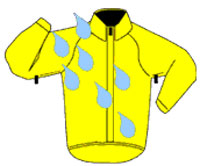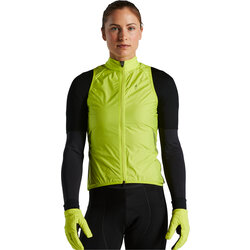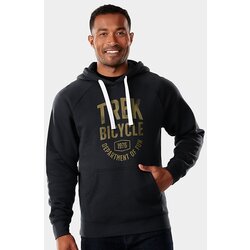Buyer's Guide To Bicycle Rain Gear and Clothing
 Waterworks are wonderful when you're wrapped in wet-weather wear
Waterworks are wonderful when you're wrapped in wet-weather wearIf you've never tried modern rain gear, you're in for a pleasant surprise. Protected by waterproof wonder fabrics that breathe to prevent overheating, you can ride for hours remaining warm, dry and comfortable. Spinning down the road and trail in the rain, you'll feel like you're a kid again dressed in rubber boots and a yellow slicker jumping in every puddle you see. Instead of dreading wet weather, you'll appreciate the variety it brings to your cycling.
Trash Bags and Ponchos
In a pinch, you can make a cycling raincoat out of a garbage bag by cutting holes for your neck and arms. This works pretty well for keeping dry, however, you generate so much heat pedaling that you get soaked with sweat. Yuk.
Another standby is the poncho, a cape-like raincoat that does a fair job of keeping the rain out. Unlike the trash bag, ponchos flap around enough to provide some cooling ventilation. Unfortunately, this flapping catches lots of wind, too, which makes it harder to maintain your pace.
Rain Relief
Luckily, bicycle-apparel makers recognize the importance of reliable rain wear and they've created impressive materials and clothing designs. Today you'll find everything from basic plastic rain jackets that a century rider or racer might carry for lightweight protection to full-blown rain suits with high-tech fabrics and features.
In fact, wet-weather wear can be so high tech, we decided to put together this guide to the category. We hope it helps you find the right gear and turns you into a veritable pedaling "Rain Man" (or woman)!

Waterproof versus Water Resistant
To be truly waterproof, rain gear must be made of waterproof fabrics and have sealed or taped seams so that rain cannot leak through the small perforations made by sewing needles during construction. Sealing and taping seams takes special equipment and extra time and adds to the garment's cost.
If the gear features water-resistant fabric, it usually means that a coating has been applied to the material to help repel water. Water-resistant fabrics work well for light rain and drizzle. But, they won't handle steady rain. If you're looking for real protection, get true waterproof fabric.
Breathability and Moisture Management
Being waterproof means that moisture won't pass through the fabric so rain can't come in. But -- and this is a big but -- sweat can't go out, either. Cycling generates so much heat and sweat that the only way to stay dry inside and out is to have a garment that's not only waterproof but that breathes and wicks moisture, too. Breathability and moisture management are obtained through venting and/or fabric construction.
Venting
Vents allow air into the garment preventing overheating. Vents can be simple mesh panels or specially designed zippered openings or Velcro vents which you open and close to adjust your body temperature. Simple mesh panels that can't be opened and closed let air in, but are not designed to keep water out. More sophisticated (and expensive) vents allow air in and keep water out. Apparel's cost is affected by the number and type of vents it has.

Here's how Gore-Tex works its magic
Cycling rain-gear fabrics fall into one of the following three categories:
1. PVC or poly-vinyls
Completely waterproof, but can't wick moisture or breathe without exterior vents or mesh panels. These fabrics are generally used in basic plastic rain jackets.
2. Coated fabrics
Nylons or polyesters with waterproof coatings. Fabrics that are coated rather than laminated tend to be a little softer... less noisy, too. But they're not as waterproof. Some examples of coated fabrics include: Hydro-No, Power-Tex, Ultrex, Breath and Hydroflex.
3. Laminated fabrics:
Nylons or polyesters laminated to a microporous membrane (2-ply laminate), and sometimes to an additional layer of fabric designed to wick moisture (3-ply laminate). Laminates are layers of fabrics glued or heat bonded together. Laminates are more waterproof than coated fabrics but they tend to be a little stiffer and heavier. Examples of laminates include: Aqua-No, Bosui, Challenge, Dermizax, Gore-Tex (see illustration), XALT.
 Stormy skies have met their match
Stormy skies have met their matchHere are explanations of the great features you'll find in today's rain wear:
Don't forget the booties!
Booties are snug-fitting waterproof or water-resistant shoe covers, which help keep your feet warm and dry. They protect the shoes, too, which helps them last as long as possible.
Now that you've poured over our rain-gear advice, come visit to try some on!




